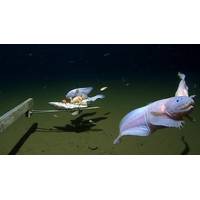
Scientists Find World's Deepest Fish
scientific expedition.The expedition's chief scientist, Professor Alan Jamieson, said on Monday that two snailfish were caught in traps set 8,022 metres underwater in the Japan Trench, south of Japan, during a two-month voyage by a team from the University of Western Australia (UWA) and the Tokyo University of Marine Science.The snailfish, of the Pseudoliparis belyaevi species, are the first to be caught below 8,000 metres, the expedition said. It wasn't immediately clear how big the fish were, but the species has been recorded as reaching a length of close to 11 centimetres (4.3 inches).Remotely
Saab Leopard Rules the Waves
In a bid to master mountainous seas the Saab Seaeye Leopard ROV system recently delivered to Japan’s Kaiyo Engineering an active heave compensator (AHC) to its launch and recovery system. Kaiyo Engineering, a specialist marine science company, is undertaking seabed research for Tokyo University and is using the Leopard to explore the feasibility of seabed mining. Adding AHC means Kaiyo can work offshore more easily in high sea states, as the AHC system will accurately maintain the exact relative depth of the tether management system from which the Leopard is deployed by compensating

The Island of Gold, the Leopard and the Falcon
the oceans offshore the seabed still holds a wealth of gold and other valuable mineral reserves created by hydrothermal activity from hot water venting at 300°C which contains dissolved metals that form ore deposits when cooled. Seeing the potential for extracting these minerals, Tokyo University has engaged Kaiyo Engineering, a specialist marine science company, to undertake seabed research using two Saab Seaeye robotic systems, the Leopard and the Falcon, to explore the feasibility of mining the gold, cobalt and the copper-rich manganese crust. The University’s program



 February 2024
February 2024





